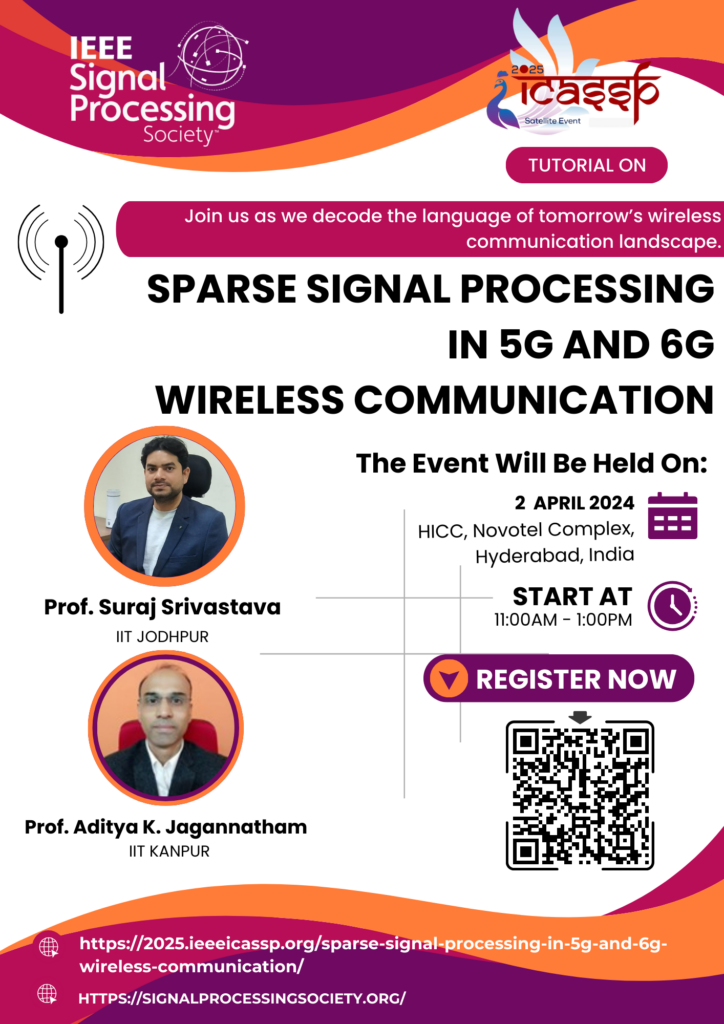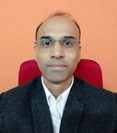CLICK HERE TO REGISTER NOW
Sparse Signal Processing in 5G and 6G Wireless Communication

This tutorial will start with an introduction to 5G mmWave massive MIMO technology, which has shown significant promise in meeting the requirements of 5G NR. However, communication in mmWave band is extremely challenging due to higher propagation losses and signal blockage. Furthermore, it is not possible to implement dedicated RF chains for each transmit and receive antennas. This brings out a novel hybrid MIMO architecture as a potential solution, which utilizes significantly fewer number of RF chains in comparison to the number of antennas in order to reduce the power consumption. In such an architecture, the overall MIMO signal processing is divided in to baseband (digital) and RF (analog) domains. Channel estimation and hybrid (RF and baseband) precoder design for this novel mmWave hybrid MIMO system are the two fundamental problems, which cannot be efficiently addressed by the conventional MIMO signal processing techniques due to the resultant large pilot overhead and constraints on the RF domain precoder design. This tutorial will subsequently explore the sparse angular domain representation of the mmWave MIMO channel and present sparse signal recovery based problem formulations for both channel estimation and hybrid precoder design in mmWave hybrid MIMO systems. Some state of the art sparse signal recovery techniques, such as orthogonal matching pursuit and sparse Bayesian learning will be described to solve the above-mentioned sparse signal recovery problems in the context of mmWave hybrid MIMO systems. Next, we will extend the sparse signal recovery based problem formulations for an mmWave MIMO OFDM system, which additionally exploits the simultaneous-sparse structure across subcarriers.
Coming next to 6G wireless communication, it is also envisaged to support ultra-high mobility use cases, where the mobile velocity can be around 400-500 km/hr for high speed trains and around 800-1000 km/hr for airplane users. In such scenarios, the impact of Doppler increases significantly and the performance of the current OFDM waveform degrades. Orthogonal time-frequency space (OTFS) is a very recently proposed waveform, which has shown improved performance over OFDM, especially for such high mobility use cases. The key feature of OTFS is that it utilizes the delay-Doppler (DD) domain representation of the wireless channel, which is extremely compact and sparse in nature, and OTFS builds a complete communication system around the DD-domain. We will demonstrate a sparse signal recovery based problem formulation for learning the DD-domain CSI in an OTFS-aided communication systems. Finally, this tutorial will conclude by describing some potential future research problems where the sparse signal processing can bring notable improvements.
Profile of the Speakers

Prof. Suraj Srivastava received the Ph.D. degree in Electrical Engineering from Indian Institute of Technology Kanpur, India, and M.Tech. degree in Electronics and Communication Engineering from Indian Institute of Technology Roorkee, India. From October 2022 to November 2023, he worked as a senior lead engineer in Qualcomm India Pvt. Ltd., where he was involved in the development of 5G-IoT modems. Previously, he was also employed as a Staff-I systems design engineer with Broadcom Research India Pvt. Ltd. and as a lead engineer with Samsung Research India, where he worked on designing Layer-2 of the 3G UMTS/WCDMA/HSDPA modems. He was awarded the prestigious Qualcomm Innovation Fellowship (QIF) twice for the years 2018 and 2022, and received the Outstanding Ph.D. Thesis award and Silver Medal from IIT Kanpur. In 2023 he joined the Department of Electrical Engineering, Indian Institute of Technology Jodhpur, where he is currently an Assistant Professor.

Aditya K. Jagannatham (Senior Member, IEEE) received the bachelor’s degree from the Indian Institute of Technology, Bombay, and the M.S. and Ph.D. degrees from the University of California at San Diego, San Diego, CA, USA. From April 2007 to May 2009, he was employed as a Senior Wireless Systems Engineer with Qualcomm Inc., San Diego, where he was a part of the Qualcomm CDMA Technologies (QCT) Division. He is currently a Professor with the Department of Electrical Engineering, IIT
Kanpur, where he also holds the Arun Kumar Chair Professorship. His research interests include next generation wireless cellular and WiFi networks, with a special emphasis on various 5G technologies such as massive MIMO, mmWave MIMO, FBMC, NOMA, as well as emerging 6G technologies such as OTFS, IRS, THz systems and VLC. He has been twice awarded the P. K. Kelkar Young Faculty Research Fellowship for excellence in research, received multiple Qualcomm Innovation Fellowships (QIF 2018, 2022), the IIT Kanpur Excellence in Teaching Award, the CAL(IT)2 Fellowship at the University of California at San Diego, the Upendra Patel Achievement Award at Qualcomm San Diego and the Qualcomm 6G UR India gift.
